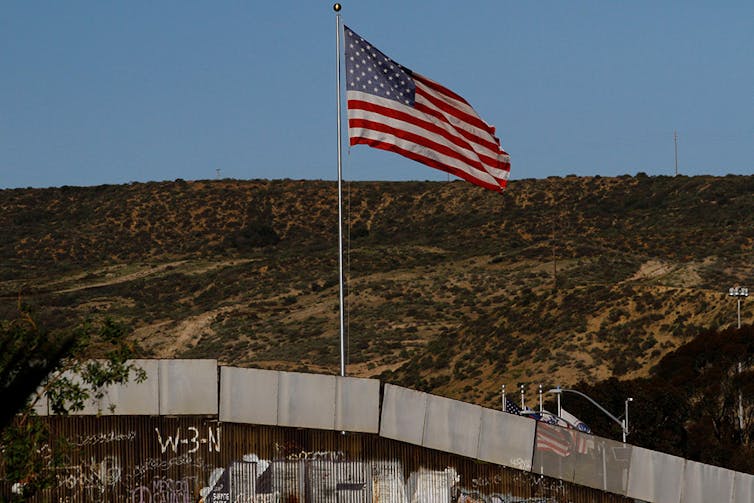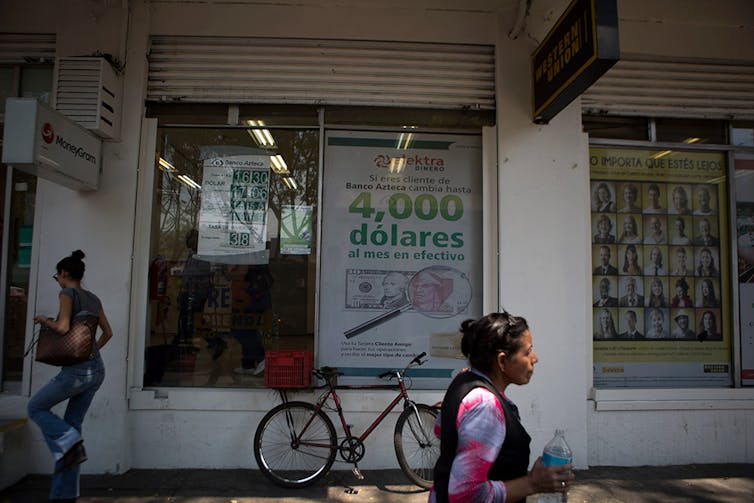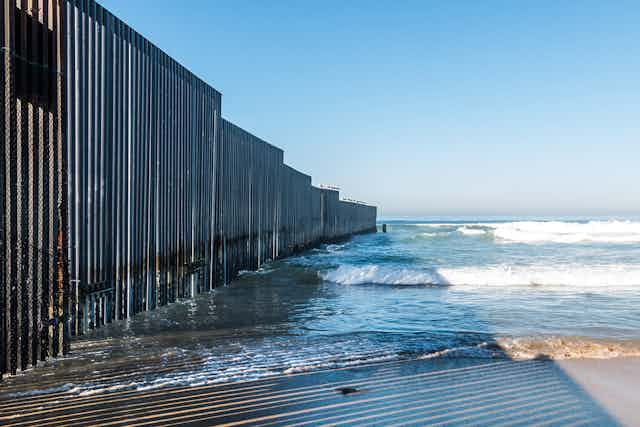President Donald Trump’s scheme to build a “big, beautiful, impenetrable” wall on the southwestern border – and force Mexico to pay for it – is wildly unrealistic and won’t be effective in keeping undocumented migrants out.
There are good reasons to be so emphatic.
Construction of the wall will inevitably be plagued by a swarm of daunting engineering, environmental and legal obstacles. And even if Trump succeeds somehow in pouring concrete from sea to shining sea, such a physical barrier would not prevent undocumented migrants from entering the United States, as decades of fieldwork-based research have demonstrated.
A formidable obstacle course of pedestrian and vehicle barriers covering about 700 miles of the border has already been built during the last 24 years. Ten surveys conducted by me and my field research team in Mexico and California from 2005 to 2015 found that these existing fortifications prevent fewer than one in 10 would-be unauthorized migrants from gaining entry into the U.S.
Inevitably, people-smugglers would take clients over, around or under Trump’s new wall, or guide them through legal ports-of-entry using false documents or concealed in vehicles, charging higher fees for their trouble.
Mexico understandably refuses to fork over a dime for a border wall, yet President Trump has ordered construction to begin while he figures out how to get Mexico to pay.
The administration has proposed several different indirect ways that it says could accomplish that. After considering the wall’s likely cost, let’s examine each of these financing options in turn.

Price tag for a wall
Independent estimates from MIT researchers and others of initial construction costs run from US$25 billion to $40 billion – a far cry from the $12 billion to $15 billion claimed by Senate majority leader Mitch McConnell – plus $500 million to $750 million per year to keep the barrier repaired.
Most of these estimates, however, also exclude the costs of land acquisition (nearly all of the affected land is in private or state hands), technological upgrades like seismic sensors to detect tunneling, temporary housing for a construction crew of 1,000 workers (if the project is to be completed in Trump’s first term) and litigation to resolve suits brought by landowners, environmental groups, Indian tribes and others affected by the project.
If Trump insists on building a a solid wall, rather than fencing of the type currently used along the U.S.-Mexico border, it will cost much more.
But for the moment, let’s assume that Congress agrees, as its leaders say they will, and appropriates whatever funds are necessary to put up a wall. And let’s also assume Mexico won’t pay, as President Enrique Peña Nieto has repeatedly declared. What can be done to keep U.S. taxpayers from footing the bill?

Taxing remittances
Trump has frequently suggested that the U.S. could tax the funds migrants working in the U.S. send to their relatives back home, in the form of money orders or other types of electronic transfers.
Remittances by Mexican migrants, who typically send $150 to $300 per month, reached a record of about $29 billion in 2016. That’s been stimulated by fear about possible restrictions on such transfers and the fall in the peso, which has made dollar remittances worth more when converted into pesos. Some of the largest U.S. companies including major banks, Visa and Western Union are involved in this highly lucrative business.
Trump has offered no details about how this tax would be administered or what the rate would be. It would have to be very high to pay for his border wall – at least 5 percent of the funds transferred. But first, Congress would have to enact a law requiring U.S. financial institutions to verify the immigration status of customers wishing to send them.
Most importantly, taxing remittances isn’t feasible because undocumented migrants have other means to send money back home that don’t involve disclosing their immigration status (or paying a tax). Mexican workers could turn to informal means to get their money into Mexico-based relatives’ hands, such as by using cargadores (mules) to carry funds directly to their home communities, sending gift cards or simply asking a family member who is a U.S. citizen or green card holder to send the money for them. There are 16.6 million people living in mixed-legal-status families in the United States.
Given these readily available options for avoiding a remittance tax, its yield would not come close to paying for Trump’s wall.

Border adjustment tax
Trump’s latest proposal to finance the wall involves levying a 20 percent “border adjustment tax” (BAT) on all imports from Mexico as part of a broader tax reform plan advocated by Republicans in Congress.
It is not at all clear that Trump has the authority to impose such a tax on Mexican imports. The Trade Act of 1974 permits a president to impose a 15 percent tariff to address balance-of-payments deficits, but only for 150 days. Beyond that, congressional legislation is required.
Moreover, a BAT cannot be imposed on just one of our trading partners, or only on countries with which the United States has a trade deficit, without running afoul of World Trade Organization rules.
Furthermore, were these obstacles somehow overcome, companies that sell products or components imported from Mexico would pass the cost of a BAT on to American consumers. In other words, the BAT becomes a sales tax. How will the average American like that $23,868 made-in-Mexico Ford Focus, up from the current recommended price of $19,890? Or paying about $2 for an avocado, 93 percent of which are imported from Mexico?
Bargaining chip in NAFTA
There has been speculation that Trump is threatening to force Mexico to pay for his wall as a bargaining chip in coming renegotiation of NAFTA.
In other words, if Mexico were to make significant concessions on a new trade deal with the United States (for example, a change in “rules of origin” governing what counts as a finished good produced within the NAFTA area, benefiting U.S. manufacturers and reducing competition with China), Trump might scale back his demand that Mexico pay in full for the wall. Or he might withdraw his proposal to tax remittances. Thus, revamping NAFTA could be another backdoor approach to making Mexico pay.
But this negotiation strategy has no credibility in Mexico. After more than a year of unrelenting threats by Trump to scrap or radically renegotiate the treaty, Mexicans increasingly view NAFTA as already dead, likely to be replaced by a bilateral trade agreement or nothing at all.
It’s true that Nieto has an extremely weak hand to play. He began this year with an approval rating of 12 percent – the lowest for any Mexican president since systematic opinion polling began. The Mexican economy is weak – projected to grow less than 2 percent this year – and inflation is rising. But knuckling under to Trump would only further erode what remains of Nieto’s public support and make Mexico ungovernable for the remainder of his term, which expires in 2018.
It is delusional to think that Nieto or any other Mexican president could withstand the political firestorm that would be touched off by caving in to Trump’s pressure. Mexico now has a highly competitive electoral system. The president’s party must stand for reelection every three years for congressional seats and every six years for the presidency. Backing Nieto on such an emotionally charged capitulation would be tantamount to political suicide for the his Institutional Revolutionary Party.
The bottom line
Trump’s executive order to begin construction of a new border wall and his continued insistence that Mexico pay for it are political theater, intended for consumption by his U.S. base.
The ways he has suggested he’d make Mexico pay aren’t likely to work and, if implemented, could cause serious economic damage on both sides of the border. Nearly five million U.S. jobs depend on trade with Mexico. If Mexico’s economy is weakened, either by a trade war or a sharp decline in remittance income, pressures for migration to the U.S. will increase.
One way or another, it is U.S. taxpayers who will pay for Trump’s border wall – not Mexicans. And we are unlikely to get our money’s worth.

